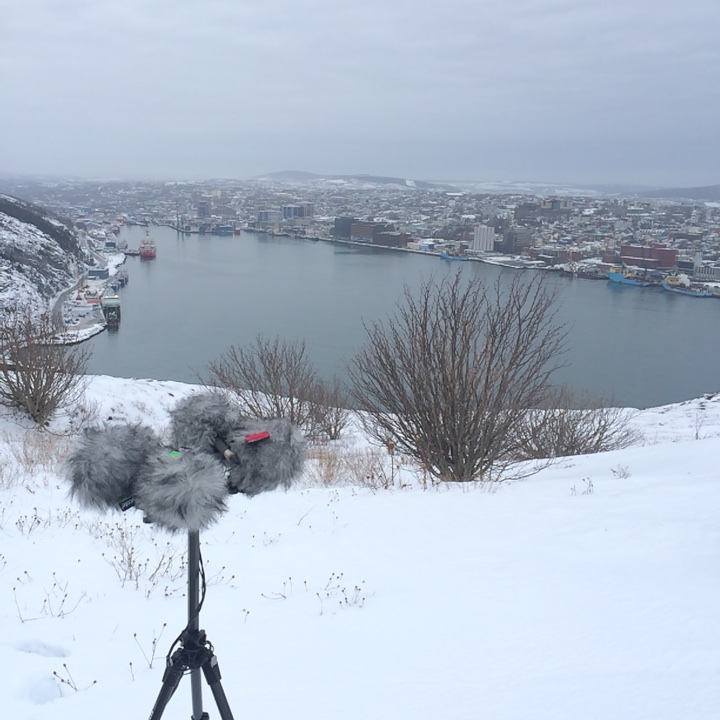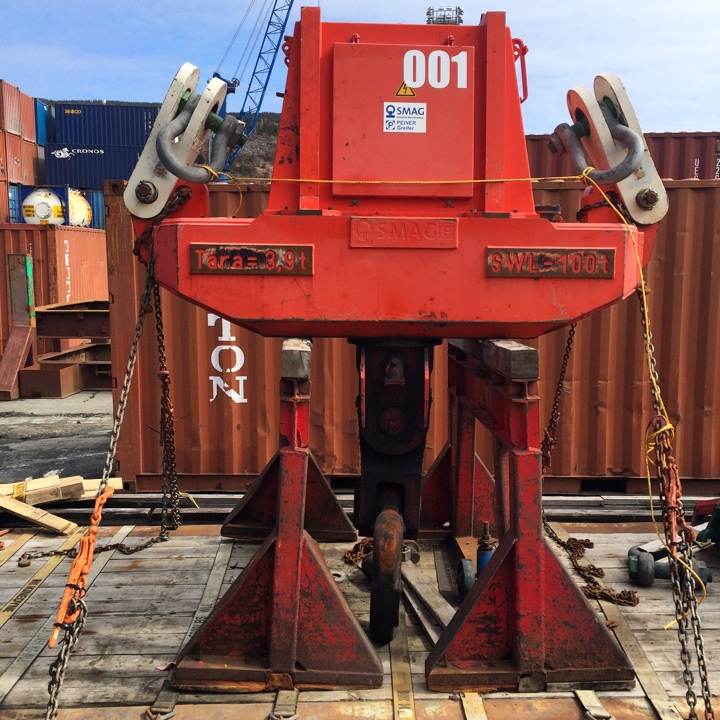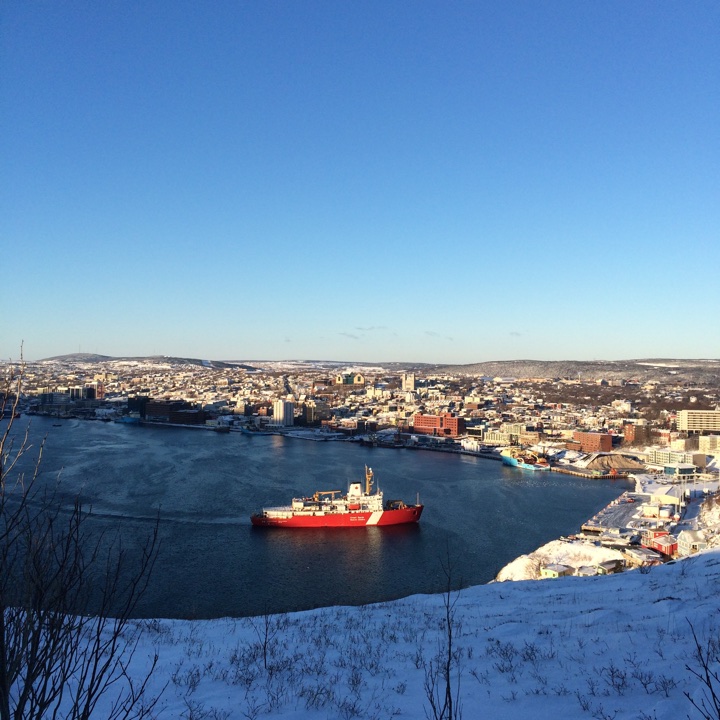
Michael Raphael has been recording and releasing high res sound effect collections for sound designers and editors since 2010. His site Rabbit Ears Audio covers such diverse sonic ground as Hind Helicopters, train whistles, and typewriters. In a recent collaboration with Audio Director Rob Bridgett he has released a new library called Port of Call and they’ve kindly offered to give us some insight into its creation. Many thanks to Michael and Rob for this contribution.
The harbour and waterfront area of St John`s, Newfoundland is an incredibly noisy and gritty place throwing a great many challenges in the way of sound recording , especially during the winter months (December through to April). Extreme winds (100kph plus), -20 C temperatures, and lethal ice-covered side-walks (not fun while carrying recording equipment) are amongst the many hazards faced. Even in the summer recording down-town is still challenging thanks to the ever present wind, but also the sound of Harley Davidsons and super-charged engines, which will unfortunately grace any ambience recording made in St John`s… meaning a lot of editing.
The unique aspects of the harbour (both acoustically as well as the low volume of air traffic) made it worth overcoming these challenges, offering a huge variety of recording positions, with access to surrounding hills for distant ambience, as well as very close-up positions right in the harbour itself. Absolutely everything in Newfoundland is imported, either by road coming from the West of the island, or by ship arriving directly into St John`s – this includes food! All of which makes it a busy, bustling, hub of activity and consequently a source of many interesting sounds.
Distant Quad Ambience
One of the most difficult and most beautiful sets of recordings came from the first day. We were looking for clean distant perspectives. The cove around St. John’s creates a lovely, natural chamber for industrial sounds to reflect off and we were looking to capture the depth of those sounds. The rig we settled on was a double ORTF arrangement of Schoeps CMC5’s with MK4 capsules. These mics were powered by the pres in a Cooper CS104 and fed a sound devices 744T. The Cooper allowed us to push a significant amount of clean gain and end up with lovely drones, beeps, bangs, foghorns, and boats rolling into the harbor.
In order to achieve the distant perspectives we found ourselves climbing snowy cliffs and generally suffering the hardships of the Newfoundland winter. Signal Hill, overlooking the approach to St. Johns is considered unsafe to hike in winter, with ice and deep snow and a more than 200 ft drop to the waters of The Narrows below. We definitely nearly lost Michael a few times (Port of Close-Call might be a good alt-name for the library – heh heh!)
[soundcloud url=”https://api.soundcloud.com/tracks/225305683″ params=”color=ff5500&auto_play=false&hide_related=false&show_comments=true&show_user=true&show_reposts=false” width=”100%” height=”166″ iframe=”true” /]
Oceanex Shipping Terminal (stereo)
As Michael mentioned, shipping terminals represent a unique challenge for sound recordists in terms of access and proximity. Luckily the terminal in St John`s is fairly accessible and there are a variety of sounds unique to these places that we specifically targeted here. The reachstackers were recorded at the Oceanex shipping terminal. There was only one good listening position to get close enough to the action whilst at the same time blocking the noise of the busy highway right next to the facility. Timing was crucial. The reachstackers themselves are dinosaur-on-steroid versions of the traditional fork-lift. The Taylor Loaded Container Handler THDC Series and the HR45-31 Yardmaster II Reachstacker are amongst the vehicles in action here. They were recorded moving large, resonant Tanktainers (containers embedded inside an open shipping container frame.) as well as traditional shipping containers. Watching the operators move the containers around and stacking them is pretty awe inspiring. As they gently lower these extremely heavy weights perfectly into place it feels like nothing more than a very well co-ordinated ballet of movement and noise.
Another of my favourite, iconic sounds from the terminals are the extremely loud reversing beeps emitted by a distant Liebherr crane (much like the reversing beeps on regular trucks, but super-charged so that everyone can hear them, even if they’re wearing ear protection). The sound is a unique feature of the Oceanex terminal and also the Harvey Marine base. Again, very hard to record this material in isolation, partly down to the general noise of loading and unloading to nearby diesel trucks, but also the proximity of city-centre traffic flows. However on the recording included in the library there was a rare Sunday-morning moment of quiet on the waterfront, and the distant piercing sound rang through very clearly.
There are also a great variety of diesel engines and water pumps running constantly on the waterfront, and many of these are added here too, from a variety of perspectives – all playing their role and adding their voices to the overall din.
Harbour Ship Air Compressor Blasts (stereo)
The ship horn blasts represent many days of recording from a variety of vantage points around the harbour. Every two years the Sound Symposium in St John`s hosts 10 days of co-ordinated ship horn improvisation known as The Harbour Symphony; essentially any vessel that happens to be present has the opportunity to join in. Graphic scores are sent around to the ships on each day and the blasts are co-ordinated by the harbour master over their secure radio network, taking place every day at 12:30 until around 12:45. There is never any way to know ahead of time what ships will be present, or where they will be spatially, so the scores tend to be entirely rhythmic and very unpredictable (I had the chance to get my hands on a score grid and view it first hand with one of the organizers of the Symposium, Mack Furlong).
[soundcloud url=”https://api.soundcloud.com/tracks/225308456″ params=”color=ff5500&auto_play=false&hide_related=false&show_comments=true&show_user=true&show_reposts=false” width=”100%” height=”166″ iframe=”true” /]
The timing meant that every lunch-time I could rush down to the harbour front, squeeze through a small gap in the fencing surrounding one of the more perfectly isolated spots in the waterfront, setup, and record. On nearly every day of recording there was extreme wind, which meant getting the mic down into a very low recording position where there was a good chance of finding shelter. The assembled vessels in the harbour predominantly use air compressor horns as they are extremely loud, but they also tend to wear in (or wear out!) over time and each one seems to have its own personality and voice. Some of the unique things you will hear in these recordings are paired and grouped ship-horns, playing like chords, as well as nice individual horns of varying lengths.
A lot of the time the public, particularly tourists arriving from cruise ships, aren’t aware of The Harbour Symphony and they’re treated to a sonic apocalypse down on the waterfront. And each day, sitting amongst them with my recording rig, I was more than able to imagine that this indeed is what a maritime apocalypse would sound like.

